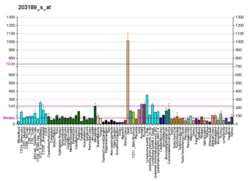Clinical significance
Mutations in NDUFS8 have been associated with mitochondrial diseases, which can cause any one of a clinically heterogeneous group of disorders arising from dysfunction of the mitochondrial respiratory chain. The phenotypic spectrum ranges from isolated diseases affecting single organs to severe multisystem disorders. Common clinical features include ptosis, external ophthalmoplegia, proximal myopathy and exercise intolerance, cardiomyopathy, sensorineural deafness, optic atrophy, pigmentary retinopathy, encephalopathy, seizures, stroke-like episodes, ataxia, spasticity and lactic acidosis. Mitochondrial disorders can be caused by mutations of mitochondrial DNA or nuclear DNA that either affect oxidative phosphorylation proteins directly, or affect respiratory chain function by impacting the production of the complex machinery needed to run this process. [8]
NDUFS8 mutations have also been associated with Leigh syndrome. Leigh syndrome is an early-onset progressive neurodegenerative disorder characterized by the presence of focal, bilateral lesions in one or more areas of the central nervous system including the brainstem, thalamus, basal ganglia, cerebellum and spinal cord. Clinical features depend on which areas of the central nervous system are involved and include subacute onset of psychomotor retardation, hypotonia, ataxia, weakness, vision loss, eye movement abnormalities, seizures, dysphagia and lactic acidosis. [8] One case report of a pathogenic mutation in NDUFS8 found that it resulted in complex I mitochondrial deficiency and a diagnosis of Leigh syndrome. The patient’s symptoms included apnea, cyanosis, hypercarbia, hypotonia, brisk tendon reflexes, ankle clonus, and erratic seizures. Further analysis revealed increased lactate, cerebral lesions, and a hypertrophic obstructive cardiomyopathy. [12]
This page is based on this
Wikipedia article Text is available under the
CC BY-SA 4.0 license; additional terms may apply.
Images, videos and audio are available under their respective licenses.





